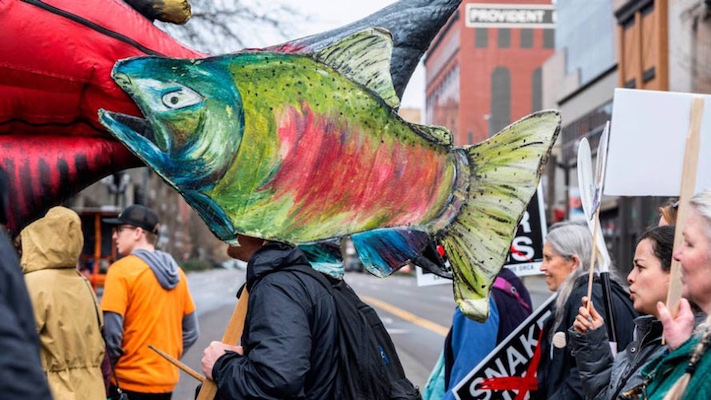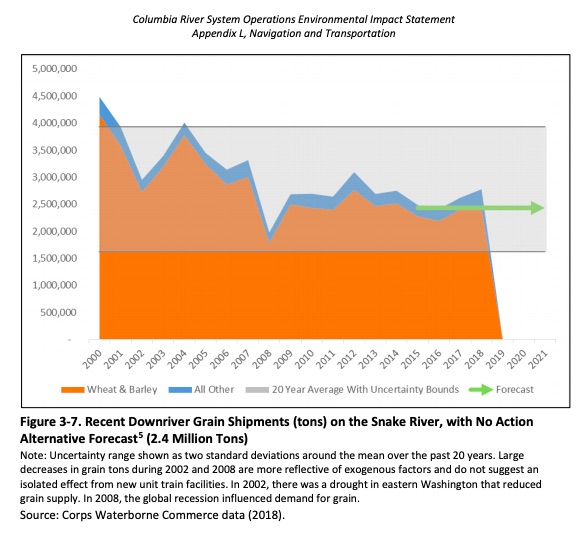forum
library
tutorial
contact

Final Federal Report on Saving Salmon
Calls Breaching Snake Dams a 'Centerpiece Action'
by Annette Cary
Idaho Statesman, October 1, 2022
|
the film forum library tutorial contact |

|
Final Federal Report on Saving Salmon
by Annette Cary
|
For Snake River fish, the "centerpiece action" needed
is restoring the river through dam removal.
 BOISE -- The final draft of a federal report on rebuilding salmon and steelhead populations in the Pacific Northwest includes a call for removing the four lower Snake River dams, among other actions.
BOISE -- The final draft of a federal report on rebuilding salmon and steelhead populations in the Pacific Northwest includes a call for removing the four lower Snake River dams, among other actions.
"To say I'm deeply disappointed by the Biden administration's report... is an understatement," Rep. Dan Newhouse, R-Wash., said as the final draft was released Friday.
The report says it supports efforts to ensure a reliable, affordable and carbon-free energy support, Newhouse said, but "there is no clean energy future in Washington state and throughout the Pacific Northwest without these hydroelectric dams."
The four Eastern Washington hydroelectric dams targeted for breaching are those from Ice Harbor Dam near the Tri-Cities upriver to Lower Granite Dam near Lewiston.
The initial draft of "Rebuilding Salmon and Steelhead in the Columbia River Basin" was released in July by the National Oceanic and Atmospheric Administration Fisheries, with the final report released Friday drawing largely the same conclusions.
Salmon Recovery actions
Breaching the four dams is just one of the actions the final report recommended for salmon recovery the Columbia Basin river system. It also calls for:
It said that for Snake River fish, the "centerpiece action" needed is restoring the river through dam removal.
That would decrease travel time for juvenile fish, reduce fish injuries and death at the dam powerhouses, reduce stress on juvenile fish that may contribute to them dying after they reach the ocean, and provide additional habitat for spawning and for young salmon, the report said.
Preparing for breaching
The final NOAA Fisheries report was released about a month after a study of what would be needed to replace the hydropower and other benefits of the lower Snake River dams, should they be breached. It was commissioned by U.S. Sen. Patty Murray, D-Wash., and Washington Gov. Jay Inslee.
Both the governor and also the senator concluded, based on their report, that the benefits of the dams must be replaced before any decommissioning or breaching of the dams.
 Benefits include allowing barging of large quantities of wheat and other agriculture products that otherwise would be moved to the coast for export by trucks and rail, increasing carbon emissions, and irrigation of farmland.
Benefits include allowing barging of large quantities of wheat and other agriculture products that otherwise would be moved to the coast for export by trucks and rail, increasing carbon emissions, and irrigation of farmland.
While salmon cannot be allowed to become extinct "it's clear that breach is not an option right now," Murray said in August.
"While many mitigation measures exist, many require further analysis or are not possible to implement in the near-term. Importantly, the Pacific Northwest cannot delay its decarbonization goals as we confront the climate crisis," she said.
But the benefits of breaching the dams are significant and they must be mitigated or replaced, the governor said in August.
Both Inslee and Murray called for federal and state governments to move forward with steps that would in time allow the dams to be removed.
The final NOAA report confirms that recovering Snake River salmon and steelhead to healthy, harvestable levels requires removal of the four lower Snake River dams and that the need to move forward is urgent, said Rob Masonis, vice president of western conservation of Trout Unlimited.
"The Murray-Inslee report establishes that it is feasible to replace the dams' benefits with smart investments. So, the roadmap is clear -- we must begin planning to remove the dams and replace their benefits," Masonis said.
Opposition to breaching
But Newhouse said that the NOAA report acknowledges that the greatest threats to salmon are ocean and climate conditions and the report also acknowledges that it lacks precise measures or estimates of the benefits of its recommended actions.
"To take such drastic recommendations on the basis of such uncertainty is ludicrous," Newhouse said.
He accused the Biden administration of playing politics with the energy future of Central and Eastern Washington, while ignoring recent data showing spring and summer chinook returns at higher levels than they have been in years.
"I will continue to educate my colleagues on the truth of this matter -- dams and fish do coexist," he said.
The final NOAA report was written in collaboration with groups that have campaigned for years for dam removal, said Kurt Miller, executive director of Northwest RiverPartners, which represents Northwest electric utilities, plus river transportation and agriculture interests.
"While it acknowledges the challenge of climate change for salmon, it neglects to recognize that removing productive hydroelectric dams would make climate change worse and cost the region billions of dollars," Miller said.
learn more on topics covered in the film
see the video
read the script
learn the songs
discussion forum
